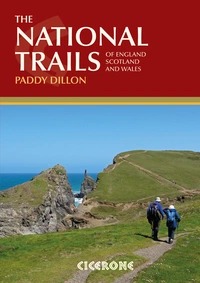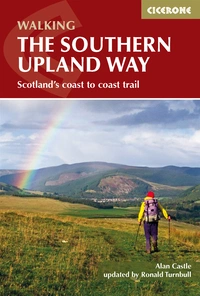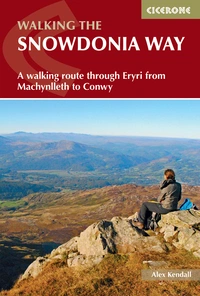Walkers and livestock: how to behave around animals
Natalie Simpson explains how best to minimise the potential risks - to yourself and the animals - when out walking around livestock
The cows had come to say ‘hello’. A semi-circle of curious heifers (young females) surrounded us as we entered the field on the public footpath. They were big. It was like that moment in primary school when, as a tiny reception pupil, you encounter the year sixes for the first time. I felt a little intimated by their size and proximity but knew it was best to remain calm and assertive. Mum and I spread our arms and took a few paces towards them and they backed off, letting us pass through the herd and continue on our way. (Note: this doesn’t work with year sixes, or children of any kind – more’s the pity!)

However, Dad and my sister opted to take a slightly different route and, for some reason, the cows decided to follow them. Dad and my sister didn’t particularly like being followed, especially as the animals were getting a little frisky. They quickened their pace slightly and gave up trying to avoid the boggy bits of the field: the important thing was getting to the exit as sharply as possible.
That’s when I noticed the bull. A huge black one, stood in the middle of the field with a small group of heifers. He was a good way off, king of the playground, standing nonchalantly with his posse. I pointed him out to Mum. By now, the cows had finally begun to lose interest in my dad and sister, who had managed to put some distance between themselves and the main herd. Mum and I had reached the gate where the footpath exits the field. And that’s when Mum looked back at the bull…
He was no longer standing passively. He was pawing at the ground with his front hoof, tearing up big clods of earth and sending them flying… Luckily, the bull was some distance away and made no move towards Dad and my sister. They crossed the field without incident, although they were scared and shaken. But the whole episode made me reflect on livestock encounters and wonder how best to minimise the potential risks.
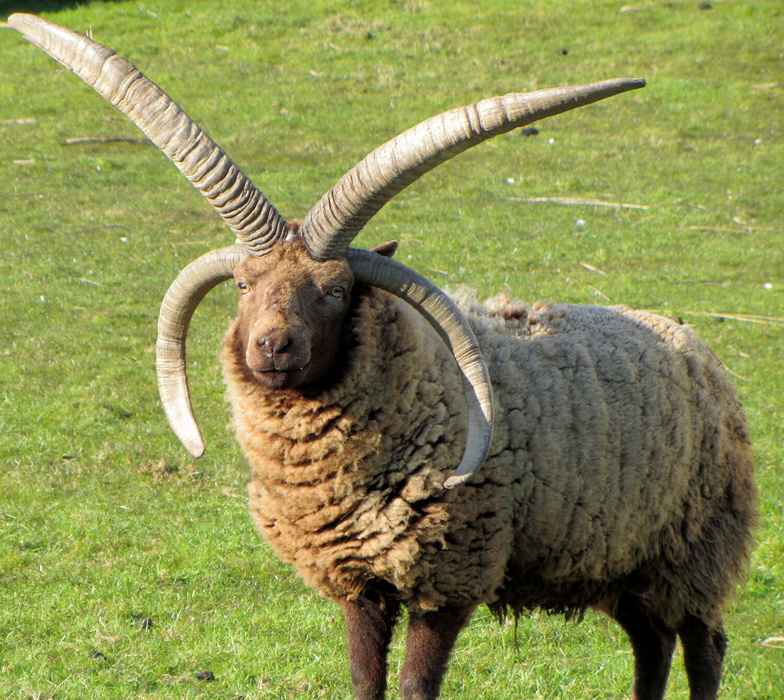
Livestock and public rights of way
Many public rights of way pass through farmland. If a footpath crosses farmland or common land where animals are grazed, the farmer has a responsibility to ensure that walkers are not exposed to unreasonable risk. Similarly, walkers must respect that the land and livestock are the farmer’s livelihood and must ensure that they do not damage crops or disturb livestock. It goes without saying that you should never interfere with animals or feed them without the owner’s permission.
Walkers with dogs have a further responsibility to ensure that their pets are kept under control at all times. Dogs – even small, friendly ones – can pose a major threat to sheep and lambs and should always be kept on a lead when there might be livestock in the vicinity. Dogs can even attack, injure or kill cows. Attacks by livestock on walkers are rare, attacks by dogs on sheep, unfortunately, far less so.
It’s impossible to remove the potential dangers altogether, but how can walkers minimise the risks to their own safety and that of livestock and pets?
Cattle
After humans, cattle are Britain’s most dangerous large animal, accounting for around five deaths and 80 injuries per year. Most are not naturally aggressive but they are big and heavy and can therefore inflict a lot of damage. Farm workers are at the greatest risk since they spend more time in close proximity to cattle. Attacks on walkers are rare but do occur, and a real or perceived threat from animals can turn a nice country walk into an unpleasant experience. Walkers with dogs are at far greater risk of attack (see Walking with dogs below). There is also evidence to suggest that lone walkers, or those walking with a single other person, are more vulnerable, as are, possibly, the over 50s and women.
Seventy per cent of fatal incidents involve bulls or newly calved cows. Although The Health and Safety Executive advises farmers not to keep cows with calves in fields accessible to the public, this isn’t law. It is also legal to keep a bull in a field through which a public right of way passes, provided the bull is not of a dairy breed, is not known to be aggressive and is accompanied by cows or heifers.
Heifers and bullocks
Heifers (young females) and bullocks (young males) tend to be naturally inquisitive. They are most likely to approach you. Even though this behaviour is usually born of curiosity rather than hostility, it can be frightening to be surrounded by large animals. However, you should try to stay calm; sudden movements can make the cattle jumpy and more unpredictable. Spread your arms wide to make yourself as large as possible and take a firm but non-aggressive step or two towards them. They will usually back off.
However, they may well continue to follow you. Keep on walking, and if they get too close, repeat the shooing method described above. With a bit of luck, they will eventually lose interest.
Cows with calves
Cows with calves arguably pose the greatest danger to walkers. Cows are naturally protective of their young and are likely to view you as a threat. Always give cows with calves a very wide berth. Check the area for calves before you proceed: they may be hidden behind vegetation. Never pass between a cow and its calf.
Bulls
Bulls are especially intimidating and dangerous by virtue of their sheer size (they can weigh up to a ton). However, since more dangerous breeds and aggressive animals shouldn’t be kept in fields with public rights of way, the chances are that any bulls you meet will prove docile. However, as my family’s story illustrates, it’s impossible to predict how an animal will react to your presence.
You should remain watchful for threatening behaviour. The first warning sign is often the ‘broadside’: the bull will turn sideways to you (while continuing to look at you) in order to show off how big he is. This is a sign that he wants you out of his space, and it’s a good idea to beat a swift retreat.
Signs that an attack may be imminent include lowering the head, rounding the shoulders forward and pawing the ground. Back away towards the nearest safe exit but only run if the animal charges at you. If you witness signs of aggression, it’s a good idea to report them to the farmer so that (s)he can remove any animals that may pose a risk to the public.
Top tips when encountering cattle
- If possible, give cattle space. Walk around them as quickly and quietly as possible. Turning sideways to them can make you appear smaller and less of a threat. Walk diagonally away from/past them at a swift but steady pace.
- Some people recommend carrying a stick to make you appear more imposing should the cattle approach you.
- Keep an eye on the animals and be alert for any changes of mood. If cattle start to display signs of aggression (see Bulls below) or you feel threatened, you should make for the nearest safe exit (even if that means going back the way you came).
- Do not run. Running will only encourage them to chase you and cattle can run far faster than humans. The exception is if the cattle charge at you and you don’t have time to make it to safety. In such instance, run at 90° to the path of the animal(s): the change of direction will slow them down and tire them.
Sheep
Sheep will not attack walkers unless you do something daft like try to separate a lamb from its mother or corner a tup (breeding male).
You pose a far greater risk to sheep, especially if you walk with a dog (see Walking with dogs below). Give them time and space to get out of your way and always keep your dog on a lead. Never let children chase sheep: stress and exhaustion can cause pregnant ewes to miscarry.
The only time you should approach a sheep directly is if it’s kessen (this is the Cumbrian term; other dialects have different words). This is when a sheep gets onto its back and is unable to rise; the resulting stress and exhaustion can prove fatal. Pregnant ewes can be particularly vulnerable. If you see a kessen sheep, help it to right itself (and then wash your hands thoroughly) or, if you aren’t confident in doing so, alert the farmer.
Ticks and lyme disease
Having said that sheep don’t pose a risk to walkers, they are instrumental in the spread of another hazard. Ticks can be present wherever sheep or deer roam. Both sheep and deer ticks can carry lyme disease, an unpleasant illness that can have serious complications. Humans can catch lyme disease from an infected tick bite.
Ticks can be present year-round but are most prevalent in spring and autumn. To minimise the risk of being bitten, it is wise to keep legs and arms covered and to check yourself for ‘passengers’ after your walk. Remember that ticks can be very tiny and hard to spot, and they like slightly moist places like armpits, elbows, kneepits and groins!
If you do get a tick bite, remove the tick either with a special tick tool or angled tweezers. If using tweezers, grasp the tick as close to the skin as possible and pull, don’t twist. Be careful not to squeeze the body (as this can cause the tick to regurgitate, which increases the risk of infection).
Not all ticks carry lyme disease, but if you are aware that you have been bitten you should be alert for possible symptoms. It is a good idea to make a note of the date of the tick bite so you can mention it to your doctor, if necessary. The tell-tale sign of lyme disease is a bulls-eye rash. However, this is not present in all cases. Lyme disease has been associated with a very wide range of different symptoms, but among the most common are fever, aches and fatigue. The symptoms can be cyclic (come in waves). If you notice any of these symptoms after being bitten, you should consult your doctor and tell them about the bite.
Some people are not aware they have been bitten and lyme disease can prove notoriously difficult to diagnose. If you spot symptoms – especially the bulls-eye rash – inform your doctor and tell them that you spend time outdoors and are concerned about lyme disease. Unfortunately, recovery can sometimes take a long time, but prompt treatment with antibiotics improves your chances of beating the illness quickly and fully.
Contamination
Sheep and cow dung carries all kinds of germs, including E. coli. Always wash your hands after accessing farmland or grazing land, especially before eating. Faecal matter and dead animals can pollute streams and rivers, so it is always wise to treat water before drinking: you never know what might lie upstream!
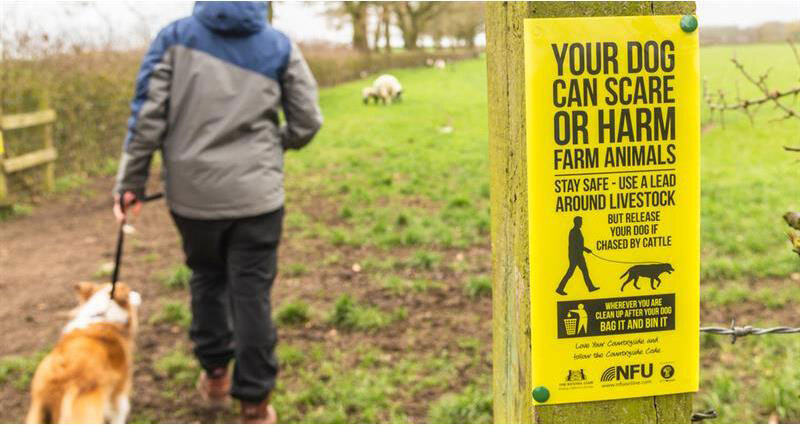
Walking with dogs
As a dog owner, you are responsible for your pet’s behaviour. (Or, if you’re walking someone else’s dog, you’re responsible for keeping it under control). You can be fined if the dog worries or attacks livestock. Contrary to popular belief, farmers do not have an automatic right to shoot loose dogs: it’s a little more complicated than that. However, they have a legal defence, meaning such action may be considered justified if necessary to prevent an attack on livestock.
Dogs and sheep
Dog attacks on sheep are a major problem – and one that ought to be preventable. Thousands of sheep and lambs are killed in dog attacks annually and farmers report that the number has increased over the past year as more and more people took to the British countryside during the pandemic. You might think your pet incapable of an attack, but it is impossible to predict how dogs will behave around other animals. All sizes and breeds are potentially capable of chasing or attacking.
And even if the dog does not actually touch the sheep, the stress and exhaustion resulting from being chased can prove fatal, especially for pregnant ewes, or can induce miscarriage.
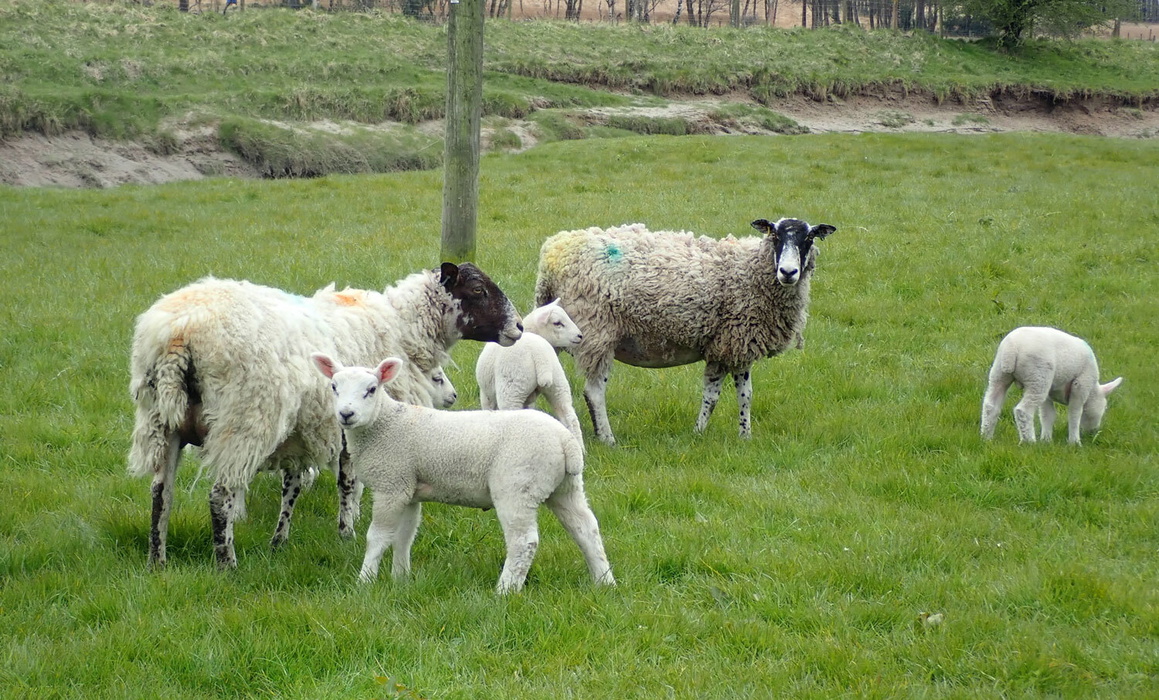
Dogs should always be kept on a short lead where there are sheep present. Remember that sheep are often grazed on moorland and common land, not just in fields: if walking on open access land, check for evidence of sheep before entering and, even if there appear to be none, always keep your dog within sight, be extra vigilant and be ready to put it on a lead at the first sign of sheep.
The mere sight of a dog can be deeply distressing for sheep, especially ewes with lambs. Allow the sheep plenty of space, a clear line of flight and plenty of time to get out of the way. If they are blocking the path, be patient. If there are other people in your party without dogs, you could allow one person to take a step or two forwards to encourage the sheep to move, but don’t walk directly towards them with a dog. In all likelihood, the sheep will quickly move away from you when they spot the dog anyway.
The NFU recommends that you should report dog attacks or loose/unsupervised dogs to the police or local farmers.
Dogs and cattle
Dogs can attack cattle, although this is less likely. The same rules and considerations apply about keeping your dog on a lead and under control. Walking with a dog also makes you, the walker, much more vulnerable to an attack from the cattle (dogs were present in all but one of the fatal cow attacks on walkers between 2000 and 2015). Cattle tend to see dogs as a greater threat than humans and are therefore more likely to become aggressive towards them or give chase. Give cattle a wide berth and be prepared for them to react to you and your pet.
If cattle start to chase or try to attack you and your dog, you should let go of the dog’s lead. It has a greater chance of outrunning the cattle than you do and will possibly distract them away from you.
Dog fouling
Dog mess is not only unsightly and unpleasant (and illegal!), it can also pose a threat to livestock. It might be tempting to think that, in a field full of sheep muck or cow pats, one more discreet bit of excrement won’t make much difference; however, that’s not the case. Dog faeces contains worms and parasites that can cause serious diseases in sheep, cattle and horses (and humans!). Clean up after your dog. Everywhere.
To conclude, walkers have a responsibility to ensure that their actions are not detrimental to livestock, and dogwalkers should take particular care to keep dogs on a lead and under control.
Farmers, too, have a responsibility to ensure that users of public rights of way are not exposed to unreasonable risk. Although the danger is relatively small, walkers should be aware that cattle can potentially pose a hazard and exercise due vigilance and caution. Nonetheless, seeing livestock – especially cute lambs and calves – is one of the many pleasures of the British countryside.
Other considerations
Access
When crossing private land, you should stick to the public right of way or permissive path. However, it is generally considered acceptable to make a small diversion (within the same field) should you need to bypass cattle that are blocking or very near the route.
Loose livestock
When walking in the countryside, you should leave gates as you found them. In some parts of the UK, livestock (both sheep and cows) roam freely on common or open access land. When driving on roads that cross such terrain, moderate your speed and be prepared for animals in the road.
- Cattlegrids may be an indication that the area you are about to access is open grazing land.
- On other roads (ie regular roads not bounded by open grazing), if you spot loose animals on or near the carriageway, try to alert the farmer. If this isn’t possible and especially if there is a likelihood the animals could cause an accident, notify the police.
Disclaimer: The advice about cattle presented here is drawn from widely accepted ‘best practice’. However, ultimately, there are no guarantees of your safety. The author and publisher cannot be held liable for any injuries resulting from encounters with livestock.

